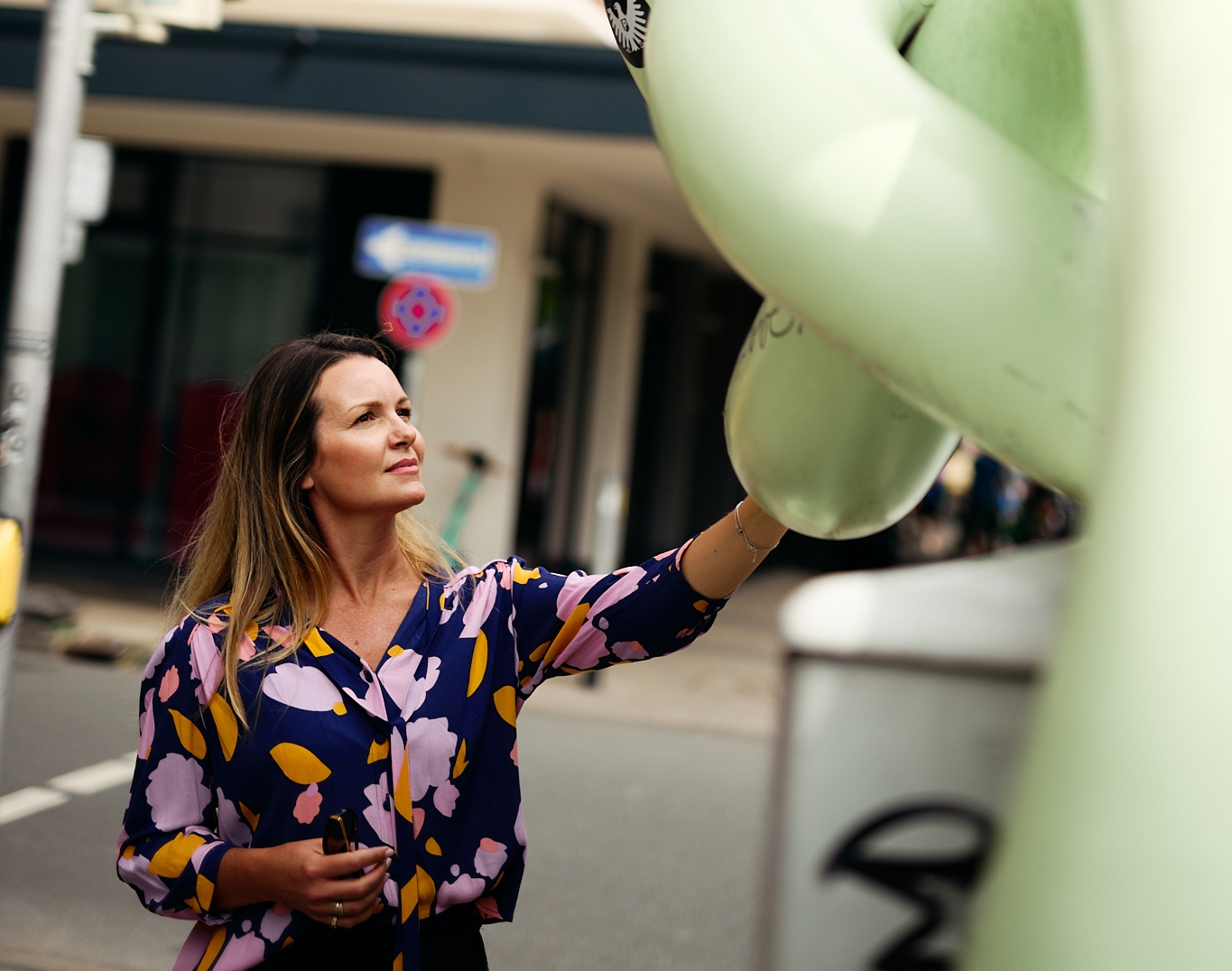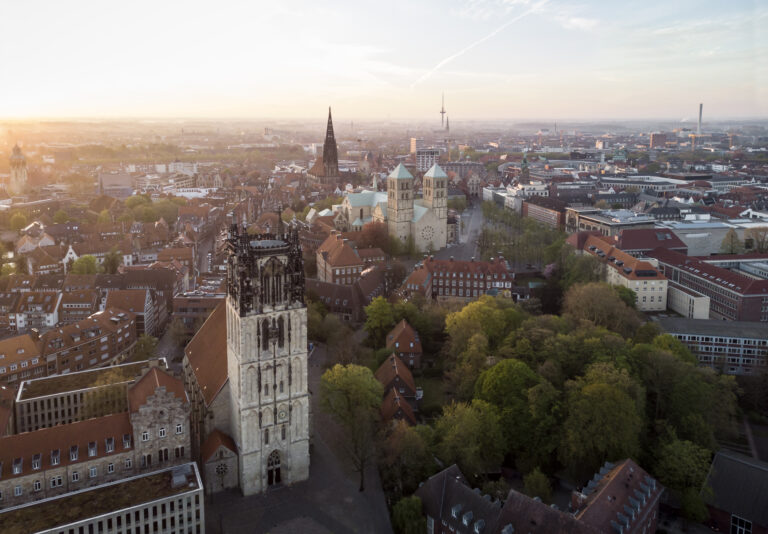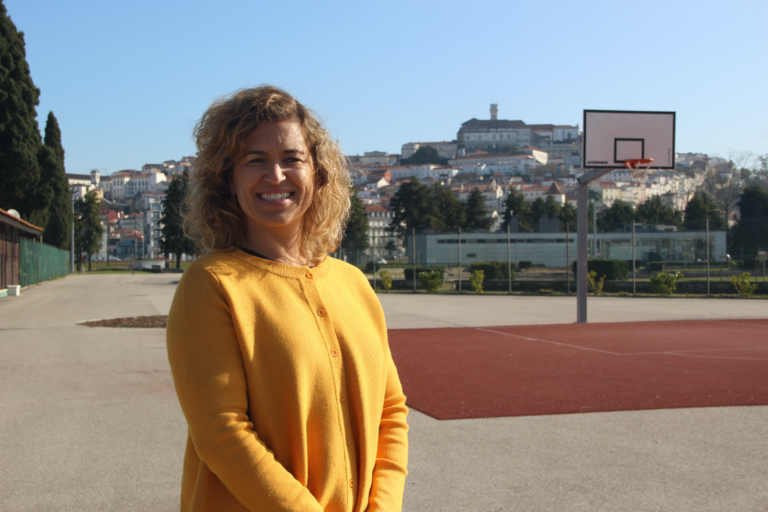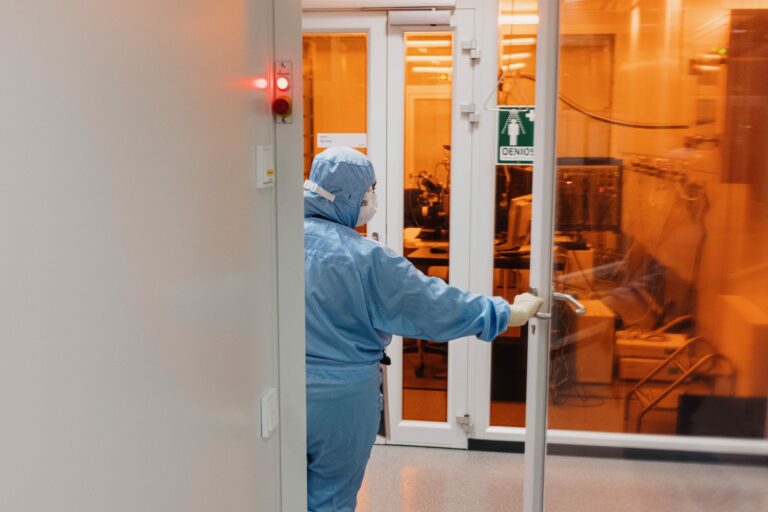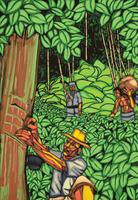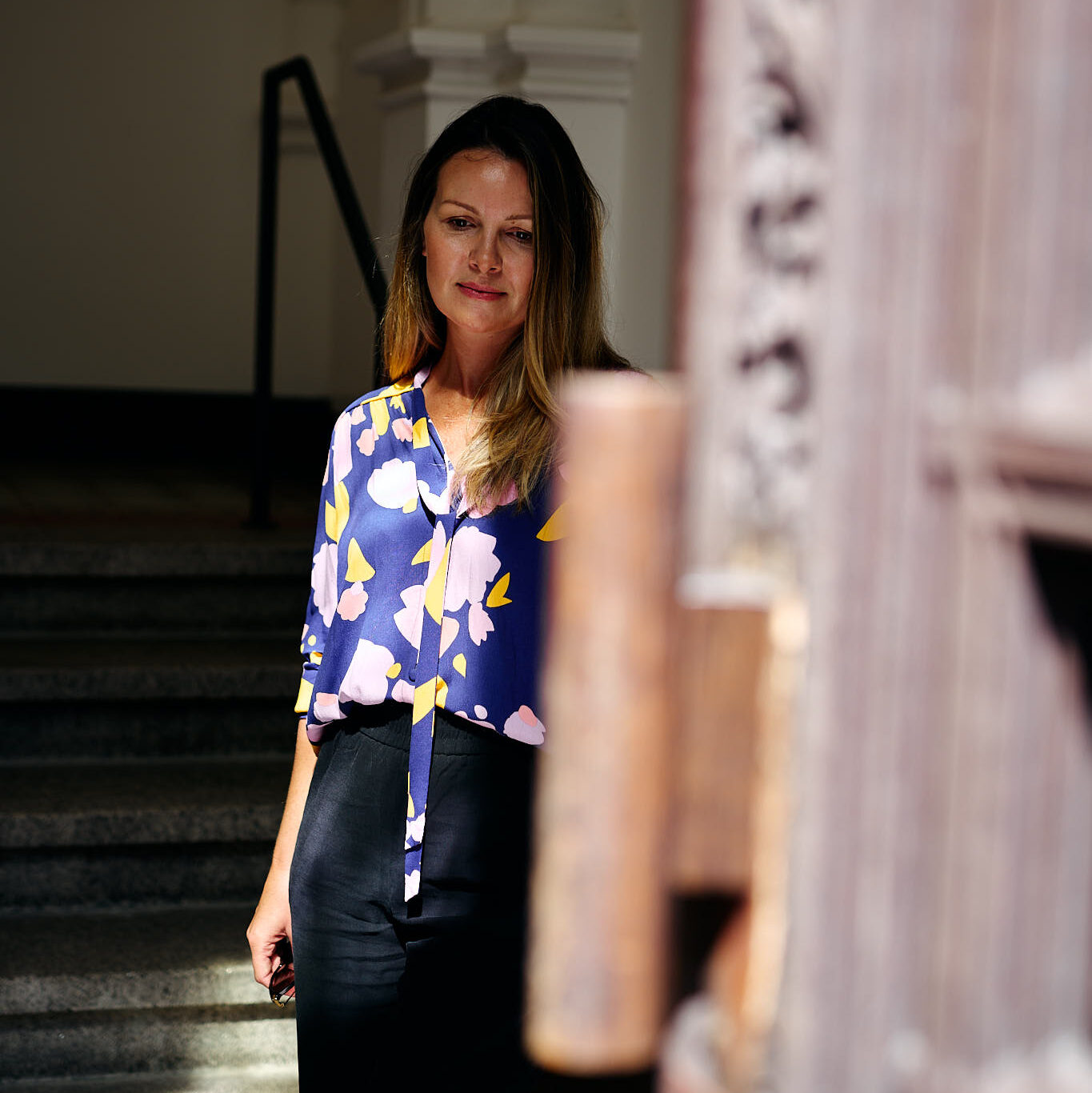
Situating Art as a Means to Agitate – an Interview with Art Historian Dr. Elisha Masemann
In the series “33 questions” we introduce, in no particular order, our WiRe Fellows who are currently working on a research project here at the University of Münster. Why 33? Well, if we think of the rush hour of life, it is kind of the age that lies in the middle. And we also like the number😉.
In today’s episode we are speaking with Elisha, art historian, passionate art traveller and nature lover.
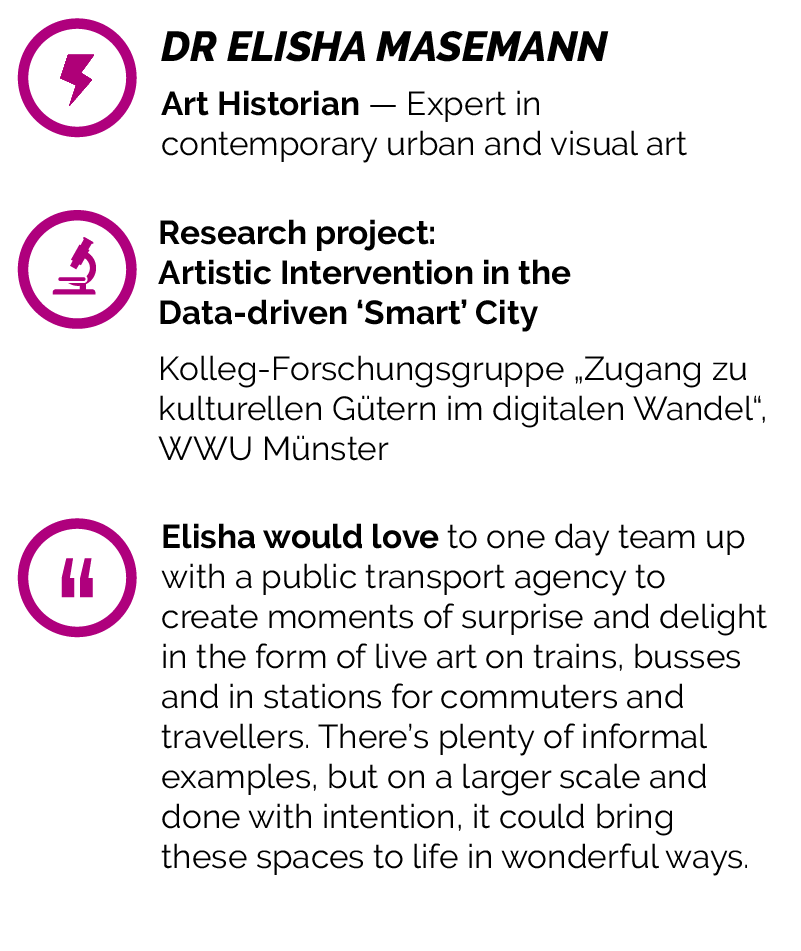
1. What motivated you to work in the field of art and urban studies?
As an undergraduate I was inspired by art from all periods, particularly early modern art. When I started graduate study in New Zealand, I felt a long way from the collections I wanted to study. I was increasingly drawn to the work of the street artist Banksy that emerged in the early 2000’s. I found there was an absence of research that studied nascent street art practices at the time and what they could tell us about the city. This dovetailed with my passion to discover cities as an avid traveller. So, I moved in a new direction. My research has evolved through a query about all kinds of creative practices, both historic and contemporary, that make vivid comments about the city as a lived experience.
2. Describe your daily work in three words.
Art, city, urbanism.
3. Describe your research topic in three words.
Art, smart cities.
4. A good art historian needs…?
Art historians usually give talks or lectures filled with images of art, so a continual flow of visual inspiration is needed. This can come from visiting galleries, artist studios and public spaces, or participating in live art, artist talks and exhibitions. In my field, physical proximity to art is a huge advantage to gather a visceral experience and convey this through writing and talks. It is also a challenge! Because works in public space are often ‘there one minute and gone the next,’ a lot of research time can be spent recording on the spot to later recall the details and sense of what was created, where, and why.
5. What does a typical (work) day look like for you?
Much of my day is spent consolidating research into written articles, which can require long hours in front of the screen. Therefore, the day always starts with physical stretching – let’s call is ‘writer’s yoga’ – which helps enormously. I enjoy listening to a podcast or doing a bit of a cryptic crossword to engage my brain. As writing is an intense workout of its own, too, I take breaks to get into the sunshine or nature where I can, as this is a great way to restore balance and often where new inspiration strikes!

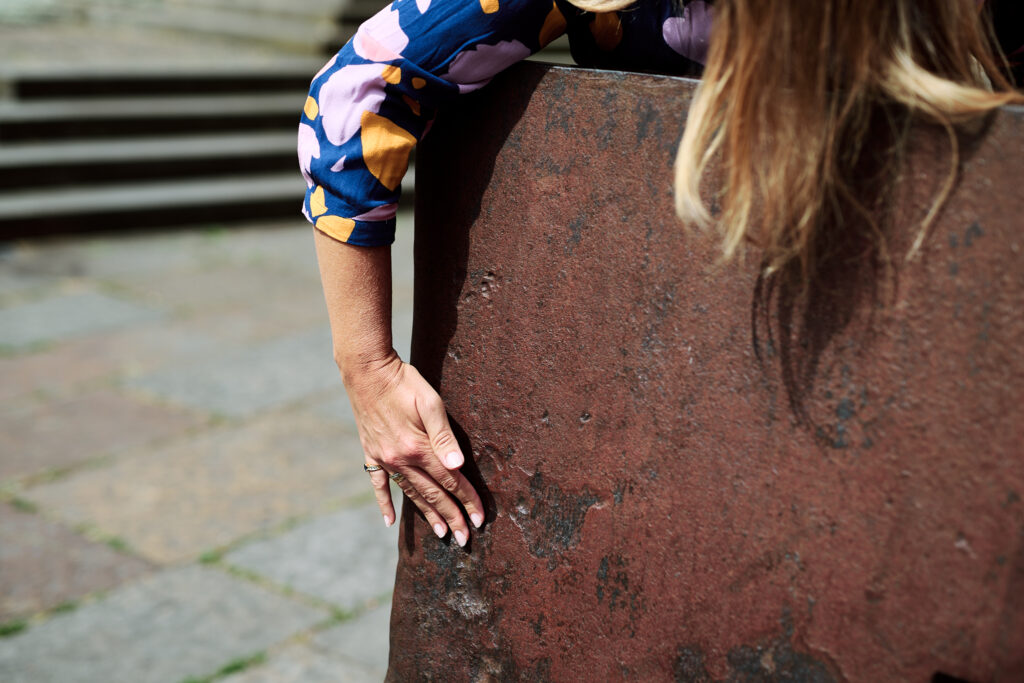
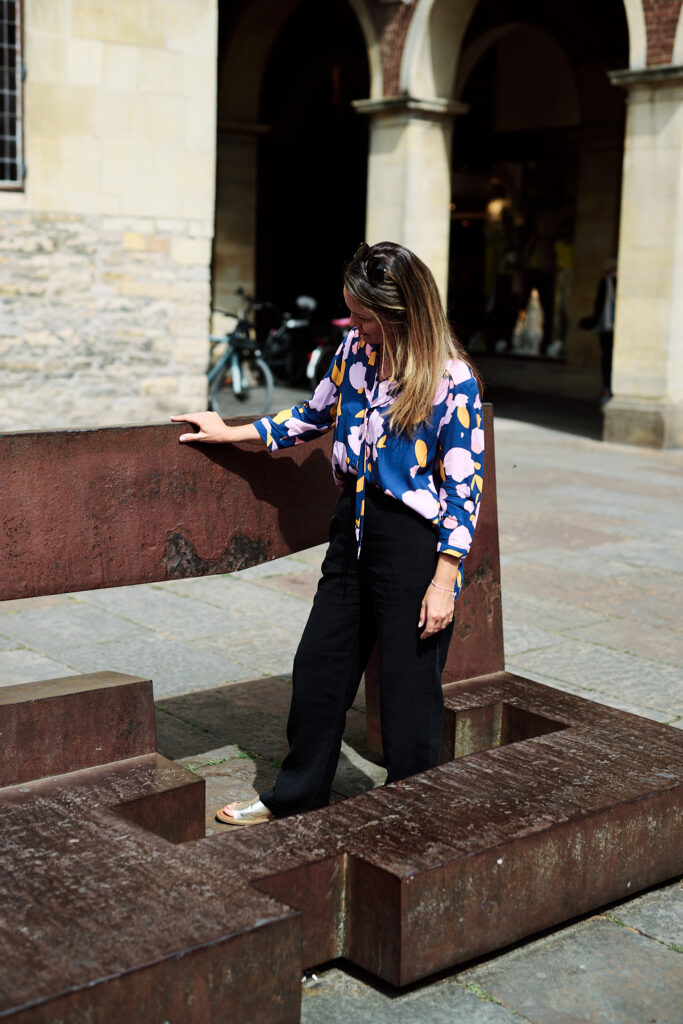
6. What is the best experience you have had as a scientist / researcher?
I’ll give you two! I was sent an email from a colleague to let me know that a UK gallery representing the street artist Banksy was auctioning a limited-edition print. I didn’t think too much about it at first, because I was a student at the time. But there was something about the timing that was intriguing. I decided to enter, knowing that due to the rising popularity of his works, Banksy prints could no longer be purchased outright, but through an auction only. The irony is still amusing as this is an anonymous artist who has typically shunned the art world of auctions and fairs. I forgot about the auction and learned later that I’d secured one of the prints. It seemed like it was meant to be since his street art had inspired my graduate level research. And yes, I still have the print!
The second experience was visiting Venice in 2017 for the Venice Biennale where both the artworks on display and the city of Venice had a profound impact on me. It’s a long journey from New Zealand to Venice (the fastest route takes around 24 hours non-stop), so it’s always a special moment to reach the other side of the world. The introduction to Venice, with its naval and architectural history, by boat is a particularly unique experience that I won’t forget in a hurry. The historic architecture of the biennale buildings was almost as captivating as the art, so the experience was full of inspiration!
7. What was your biggest research disaster? What did you learn out of it?
I’m sure many researchers and academics recall their first international conference experience. Whilst it wasn’t a complete disaster, I made the ‘rookie error’ of speaking overtime because I had misunderstood that the allocation was 20 minutes for speaking and 10 minutes for questions. The learning curve was steep, but the professional growth was equally positive. I learned how to handle myself in a difficult situation and adapt on the spot. I also learnt a valuable lesson about time management!
8. Which (historical) important scientist / researcher would you like to have dinner with? What would you ask?
Michel Foucault. I would be interested to hear what he makes of the world today.
9. If time and money were no object: Which research project would you like to do?
I’ve always thought it would be fun to team up with a public transport agency to create moments of surprise and delight in the form of live art on trains, busses and in stations for commuters and travellers. There’s plenty of informal examples, but on a larger scale and done with intention, it could bring these spaces to life in wonderful ways.
I would also love to teach art courses of my own design online and then lead guided art tours of the works studied. I would particularly like to reach women who have not had the opportunity to either study art or travel to see it, so I would use any funding for this purpose. Travel and art, in my experience, have capacity to broaden one’s outlook on life and what’s possible, which is a hugely inspiring thought I would love to share.
10. What is your favorite research discipline other than your own?
I originally wanted to study in the fine arts as a painter. Had I pursued that path, I think I would have changed to conceptual practice and pursued practice-led research.
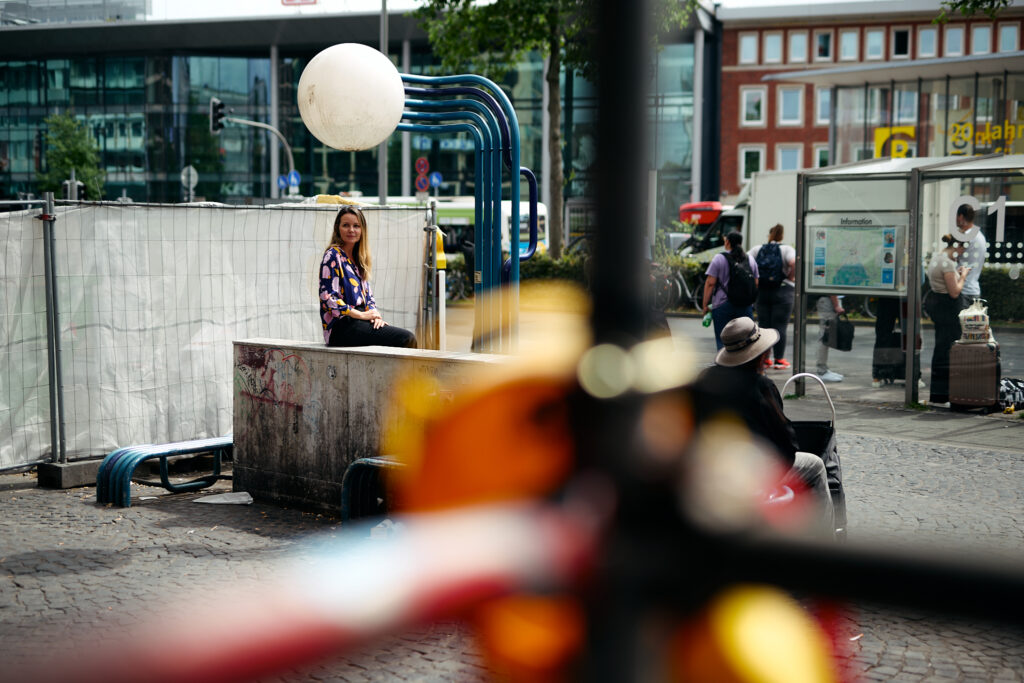
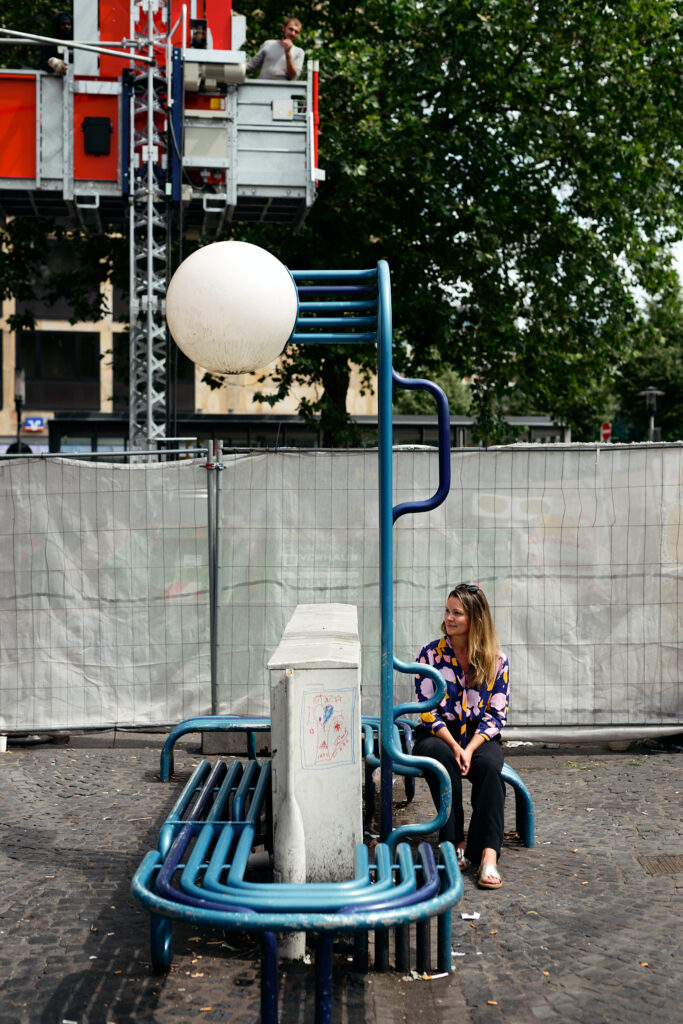
11. What was the funniest moment you had in science?
I’m not sure if I’ve had many funny moments, however I’ve had many moments of delight through the encounter and experience of art. A lot of street art has an amusing tone that is tongue-in-cheek and brings a smile to one’s face. Banksy’s self-appointed artist-in-residence in NJYC in 2016 is one example. Members of the public followed the residency which was designed like a scavenger hunt with one new work announced in a different area of the city each day. It was so interesting to see the reactions of the public to the works, especially the nonsensical ones that really disrupted the everyday scene. The works were accompanied on social media with a humorous explanation of the faux-significance of the works, which is part of the grass-roots appeal of street art.
One memory I have is discovering the work by William Pope. L called Whispering Campaign for documenta in Kassel in 2017. I had read about the work before I arrived in Kassel with my son, both of us eager to discover the city-wide exhibition. We were standing in a street, and I could hear a whispering noise which was making me aware of my surroundings, being a foreign traveller in an unfamiliar place. We were later in another area of the exhibition, and I could hear a similar disquieting whispering noise, which we discovered was actually part of the artwork. We returned to the site of the earlier work to discover it had been coming from a parked car. The “A-ha!” moment is always an amusing one!
12. What do you consider the greatest achievement in the history of science / research / your field?
The French modern artists whose works were rejected by the Paris Salon, the official art exhibition of the Académie des Beaux-Arts in Paris, because they did not meet the standard for academic art on display. Artists such as Gustave Courbet, Édouard Manet and Camille Pissarro went on to establish the Salon des Refusés in 1863 where thousands of rejected works went on display and were ridiculed by the public and critics. This development coincided with artists opening their studios to the public and hosting private exhibitions and was instrumental in bringing critical attention to the emerging avant-garde in painting. A decade later the Paris Salon had declined in popularity as the public was more interested in Impressionism.
13. Which experience in the world of science disappointed you most?
Historically, the lack of formal training and critical reception of the artwork of women artists and art historians has limited the possibilities for the field to bring a range of perspectives. Although thousands of women in Britain and France received informal training in households with male artists, they were often received as amateurs or honorary participants in major exhibitions. Given equal opportunity earlier in history, the range of works and subjects we have today might have been radically different!
Today, the study and reception of art still has boundaries that need to be addressed to make art more accessible to audiences. There is a huge imbalance between socially engaged artists who integrate art into communities and the echelons of the commercial art world where art is marketed and sold in very small circles. While digital platforms make significant ground in terms of access, these are still not accessible to all. That’s why I love to see artists who work directly in communities to bring creative approaches and solutions for changes needed at grass roots level.
14. How did you survive your PhD time, and what advice and tips do you have for future PhD students?
With a lot of self-determination, encouragement and support from my family, friends, fellow PhD students, colleagues and supervisors! They provided me with shoulders to cry on, beds to sleep in, words of wisdom and so on. I also had a great supervisor who understood my working method and believed in me to get the job done.
A dedicated, stable workspace and place of residence is key to focus and productivity. This can be a difficult combination, and certainly wasn’t something I had sorted at the outset of my PhD. I also didn’t have reliable technology which thwarted my efforts to begin with. I think investing in a space that feels like home, surrounding yourself with supportive people, and knowing how to use technology to benefit the end result, really helps. For the actual PhD subject, getting crystal clear on the topic and the “why?” early on will help immensely in the long run.
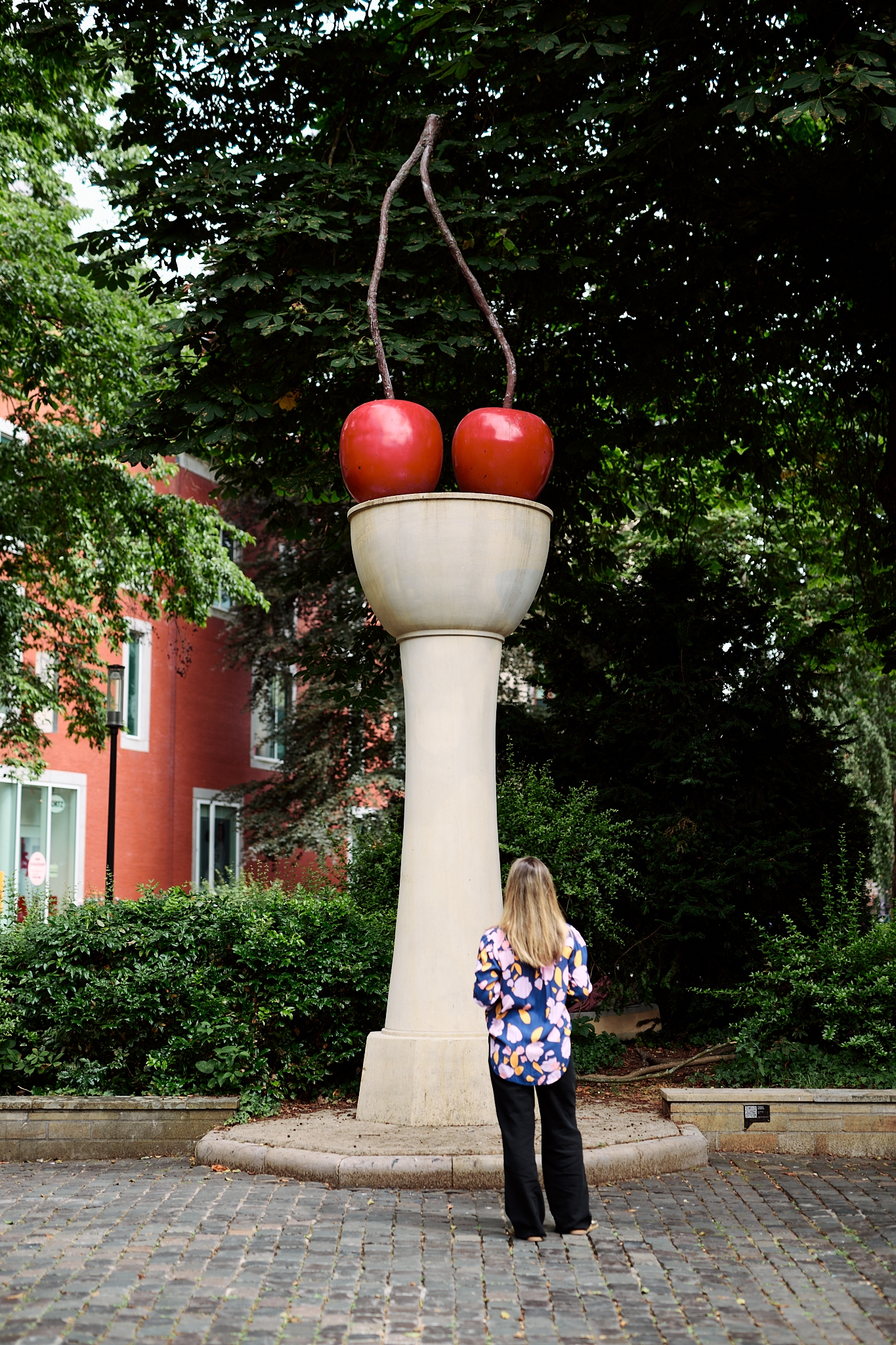
15. What direct or indirect relevance does your research have for society?
A principal concern for my research is to situate art as a means to agitate within city spaces, which participates in a broader discourse on how cities are changing in the 21st century. Art has a tendency to expose the ideological forces that organise and influence how cities are used or realised. My research aims to deliver a sustained deliberation on artistic experimentation, reflection, inclusive interaction, and spontaneity across different levels of the city. The approach is both topical and relevant to current studies of the complexities of cities as they continue to morph and evolve. Artistic interventions in urban spaces can, for example, provide insights into new, sometimes less-visible, assemblies of order, with direct relevance for urban societies.
In addition, there is now broad acceptance that Covid-19 marked a significant turning point in global terms. In many of the world’s cities access to public spaces, and individual rights and freedoms have changed, with renewed calls for greater action in response to co-existing crises such as inequality, lack of housing and infrastructure, private land development, and environmental disasters. Meanwhile the implications of new bio-technologies, A.I. and surveillance are coming under scrutiny. Such challenges offer opportunities for interdisciplinary humanities studies; research can respond to questions of what ‘humanity’ means in the context of uncertainty and crisis. In line with this, art highlights how uncertainty affects urban societies and can offer insights for building individual or community resilience. These challenges require new approaches, new observations, new spaces for discourse, and new ideas to build conviviality and greater tolerance. Art is largely accepted as a cultural practice that has capacity to reach across different layers of society to contribute a plurality of perspectives on various issues, conditions or dynamics in this global ‘moment.
16. How did you imagine the life of a scientist / researcher when you were a high school student? Is it actually different? In what way?
I didn’t imagine the life of a humanities researcher until I was an undergraduate student. I was inspired by a lecturer of mine who captured the attention of a large lecture theatre with an engaging talk on renaissance art. I felt hugely inspired at the time. I imagined a life that balanced teaching and research, which had huge appeal. I was a humble student and young mother at the time, so I was genuinely shocked when I was awarded the scholarship as the graduating student with the highest overall grades. It wasn’t until this moment I felt encouraged to consider academia as a genuine career direction. I realized early on it would require stamina and fortitude, with challenges to overcome. However, in the right moment, the right door would open and invite me to journey further.
To be honest, I still don’t really know what the life of a researcher looks like! Out of necessity, and probably like many others, my journey has had stops and starts, detours and compromises. The key is to be adaptable and believe in oneself. If the right opportunity presents itself, go for it! The world of academia is hugely competitive in my experience, and the post-doctoral world can be a challenge to gain traction, especially in the humanities where funding is reasonable ‘thin.’ I was extremely fortunate to be awarded a short post-doctoral fund that was designed to assist future women leaders in academia. It was one of just a handful of opportunities, each of them fiercely competitive. I found I reached emotional capacity after 2 years of stringing together short-term research projects and funding. I think now the key is to think more laterally about the application of one’s research and how this can fit into interdisciplinary research fields.
17. What do you like most about the “lifestyle” of a scientist / researcher? And what least of it?
I feel fortunate that my research field offers plenty of visual stimulation and provocation to engage critical thinking. It offers opportunities to travel and visit art in different cities. Coming from New Zealand, it is always an overwhelming experience to have access to so many galleries filled with art in almost any city in Europe! I love that I can share my field and knowledge with whoever is with me, such as family members. In addition, for the day-to-day research work, I’m always hugely grateful I can set my hours and work to my own schedule. One downside is that writing can feel like a lonely pursuit that not everyone understands. It’s generally okay because I like my own company! I like equally to chat with people who can stimulate my thinking in new, unexpected ways.
18. Do you think your career would have evolved differently if you were a man?
Absolutely, I’m just not sure how I can articulate it sensitively because I know there are challenges across many different levels to pursue an academic career. I recall one training session I attended as a PhD student where we were told that if women wear trousers when presenting conference papers they are taken more seriously. I objected to this, but it confirmed a fear of mine that to survive or ‘make it’ I would need to adopt a masculine way of being. I was also a solo mother raising a young child throughout my undergraduate and graduate studies. Financial hardship was a very real barrier to my progress and resulted in several departures from study into paid work or completing demanding hours of study and work as needed when I returned to graduate study full time. I was hugely fortunate to receive some financial assistance in the form of fees scholarships, and part time hours tutoring during the semesters, and I have had a very supportive family who believed in my journey, all things I’m incredibly thankful for.
19. Where do you see yourself in 10 years?
I would love to be teaching and researching in my field, sharing knowledge with the broader community and leading art tours or community-based research projects. My goal is to mentor others though academic supervision or community outreach using my experience and belief that wisdom flows both ways. I hope to be based in Europe for this, as it has been my long-term goal to settle here. I believe in a balance of heart and mind, so I also see myself practicing a non-traditional field of activity such as yoga or energy healing such as reiki. This has been proven to complement the demanding mind activity that occurs through research activity.
20. Which interest(s) have you given up for a life in academia?
Painting. I now write about it instead. But it’s something I plan to return to.
21. If you could travel in time: in which epoch and at which discovery or event would you have liked to have been there?
Great question! I could come up with a few! The late 19th century would be one – in Paris and other cities in Europe – to get a sense of what ‘modernism’ was like to live through. The works of art from this period tell us a lot about the changes in society, the upheaval, the innovations of industry, which is why this period inspires so many historians, I guess!
22. If you had a daughter, what would you advise her not to do?
The same as I advise my son – to not be afraid to follow your own path even if it seems unconventional to others.
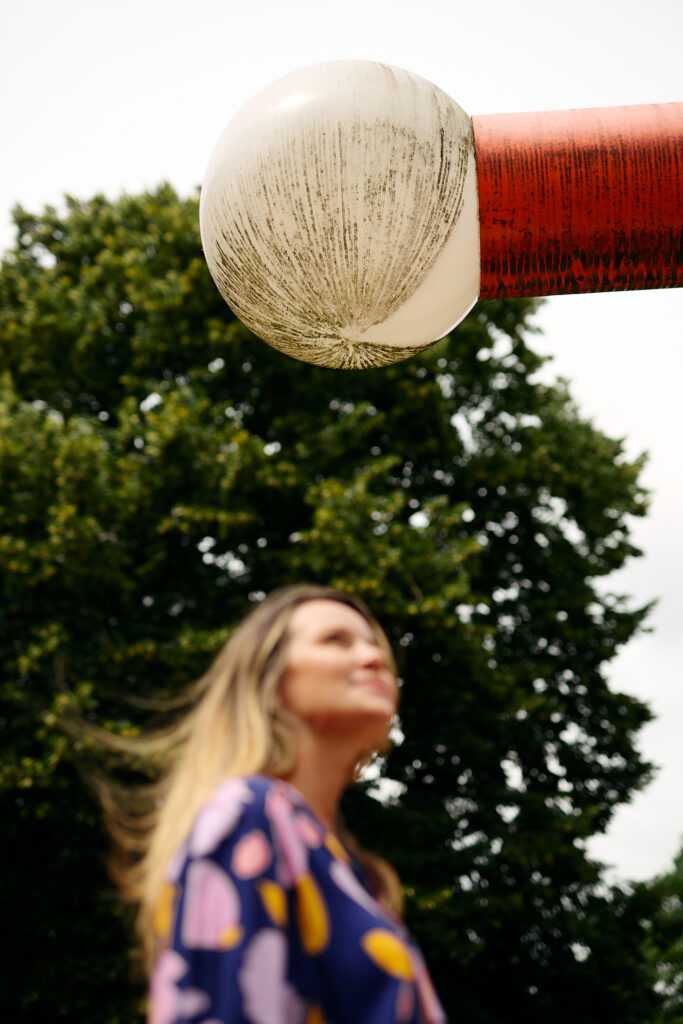
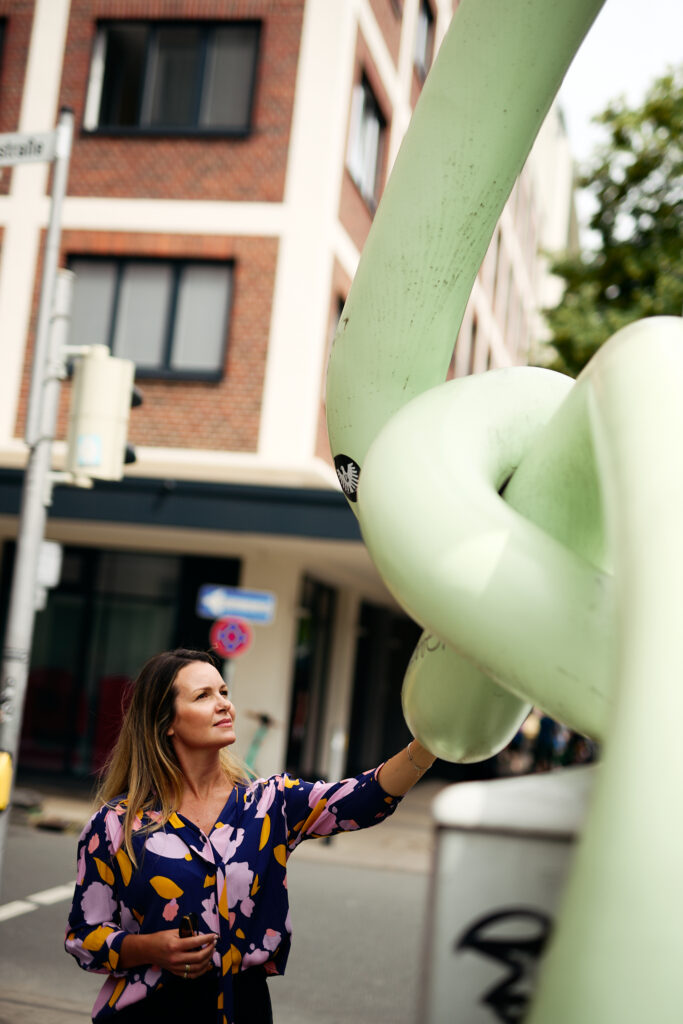
23. What is the biggest challenge for you when it comes to balancing family and career? How do you master this / these challenge(s)?
Job precarity. There are studies that show it takes on average 6-7 years for a PhD to reach tenure-track and only 10-30% will reach that goal. It’s widely known that post-docs exert huge efforts to forge ahead in research while applying for future fellowships, often moving between short-term positions that do not offer longevity or security and involving a move to a different city or country. Job precarity goes hand-in-hand with family obligation, financial security and wellbeing. When one has a family to think about and provide for, pursuit of an academic career can be a serious question that concerns everyone’s wellbeing, including one’s own. My experience has shown me it’s reason enough to think about abandoning an academic pathway.
I think it’s important to know what you want to achieve and have clarity about what you’re willing to do to make it happen. It’s equally important to know where to draw the line, to know when efforts exerted are not achieving the outcome desired. Then it’s okay to say, “this doesn’t work for me anymore,” take a break, regroup and come up with another approach. Time out is okay and it’s healthy. It sounds like a relationship dynamic because it really is!
24. How often do you as a friend / partner / mother / daughter feel guilty when you have to meet a deadline – again?
I don’t really. Family obligation always comes first, then academia. With friends I aim to manage expectations and operate on a basis of turning up in the moment if I’m able to. Meeting deadlines otherwise means working through the night on many occasions!
25. How did you imagine your future as a child? What profession did you want to pursue?
From a young age I knew I wanted my future to be about discovering the world and all its wonders. The career options I considered were working for an airline or as a diplomat.
26. How do you keep your head clear when you are stressed?
Meditation practice (and yes, it does take practice!) or walking in nature or on the beach. I also love driving on open roads for long distances to discover new places, if time allows. There was a time when research ideas and everything my mind was processing stayed with me 24/7, no evenings or weekends off. These days I find it much easier to switch off and give my mind a break, which has had a huge impact for my wellbeing and everyone who has to live with me!
27. What makes you most happy about the world?
Knowing there are good people with kind hearts everywhere you go.
28. What are the advantages and disadvantages of doing a remote-WiRe-fellowship?
Advantages: starting in a home environment to get started with resources at the ready but being in touch with the WiRe group and colleagues ahead of the arrival in Münster.
Disadvantages: not feeling ‘on the ground’ or having the chance to meet people face-to-face. Arriving half-way through the fellowship to Münster also meant a bit of disruption and loss of ‘flow’ for my project.
29. Which of your traits bothers you the most in your daily work?
I’m one of those people who saves files to my desktop ready to move later…I’m working on it.
30. And which of your traits help(s) you the most in your daily work?
I know the times of the day when I’m most productive, so when I sit down ready to work, I can focus and get done what I need to.
31. What worries you most about the world?
A prevalence of ideologies that promote division over unity and scarcity over plenty.
32. What is your favorite place to relax from research?
If I’m in New Zealand, it’s always at home, the garden outside, in nature or at the beach nearby. In Münster, I enjoy finding pockets of nature wherever I can, often a walk by the canal is a nice spot to relax.
33. What is your favorite place in Münster?
The kleingärtnerverein around the city are some of my favourite places to explore. If you’re looking for me on a weekend I can often be found appreciating these quaint and truly unique gardens. They pique my childlike wonder of growing flowers and plants and I’m always amazed how abundant the plots seem to be. These iconic gardens were also the subject of a work by Jeremy Deller for Skulptur Projekte Münster, so there is also an art connection!
The canal area and the leafy nature areas nearby also come to mind, and I love strolling through the weekly produce and flower markets in the Domplatz!
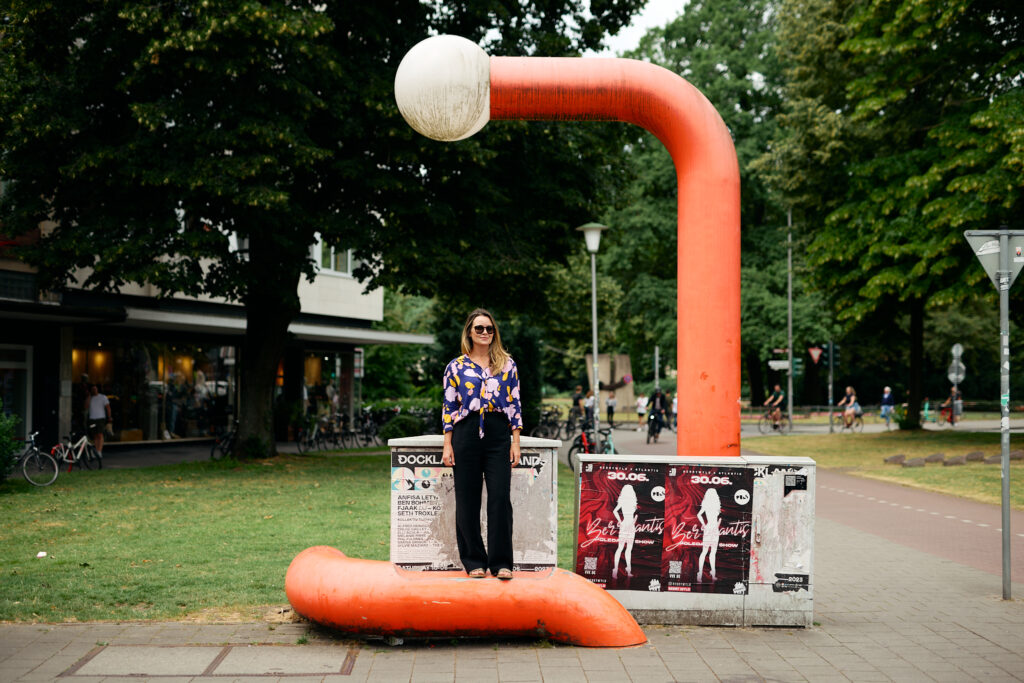
For more information about the Artworks pictured, here are some links to further reading:
https://www.tagesspiegel.de/kultur/von-bunten-raupen-und-rohrwulsten-3579925.html
https://www.skulptur-projekte-archiv.de/de-de/
https://www.stadt-muenster.de/galerie/skulpturen/bild/kirsche
https://www.kunsthallemuenster.de/de/sammlung/eduardo-chillida-toleranz-durch-dialog-1992-519616/

